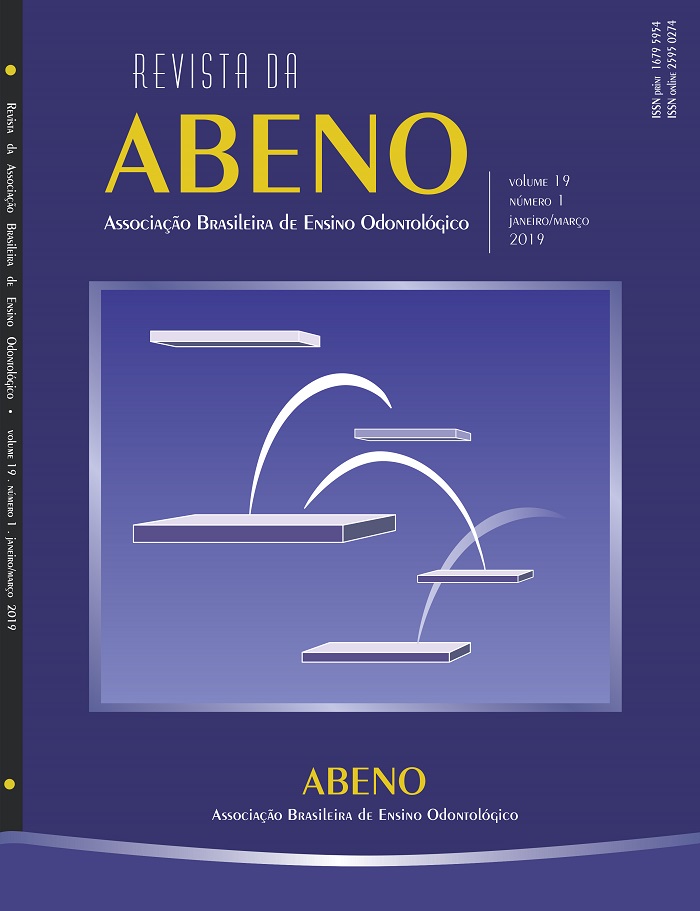Profile of Brazilian Dental Undergraduates who participated of Science Without Borders Program and their perceptions on sandwich course
DOI:
https://doi.org/10.30979/rev.abeno.v19i1.695Palabras clave:
Dental Education. International Educational Exchange. Higher Education.Resumen
The Science without Borders (SwB) program was created in 2011 aiming to internationalizing education in Brazil and providing highly qualified training abroad. However, in 2015, it ended the offer of scholarships for undergraduates, which allowed several opportunities. The objective of this study was to evaluate the profile of Dental undergraduate students who participated in the SwB program and their perceptions about this experience. This is an evaluative research developed with students who participated in SwB in the sandwich modality, in which the student continues being enrolled in his university of origin, while studying for period in another institution abroad. Semi structured questionnaire was developed using the GoogleDocs® digital platform, addressing the sociodemographic and academic profile of participants and aspects related to the organization and operation of the program. From 745 former SwB Dental students, 109 (14.6%) answered the questionnaire. Most of them were female (65.1%), from public institutions (89%), located in the Northeast (34.9%) and Southeast (26.6%), with proficiency in English (82.6%), and intention to become a researcher (51.4%). The fellows indicated that the program's objectives were partially fulfilled (59.63%). They considered themselves more qualified, professionally, due to the sandwich course offered by SwB. However, they pointed out several limitations: lack of organization of development institutions, use of disciplines and control and inspection mechanisms. It was possible to outline the profile of program participants, as well as to characterize the functioning of SwB for Dental students, according to their perceptions.
Descargas
Citas
Knight J. An internationalization model: meaning, rationales, approaches, and strategies. In J. Knight, Higher Education in Turmoil: The Changing World of Internationalization. Rotterdam, The Netherlands: Sense Publishers. 2008: 19-38
Sehnem PR. Os programas Erasmus e Ciência sem Fronteiras como materialização da internacionalização universitária. Brazilian J Dev. 2019;5(1):533-55.
Brasil. Decreto nº 7642, December 13, 2011. Institui o Programa Ciência Sem Fronteiras. Diário Oficial, Brasília, DF: Dec 13 2011.
Ministério da Educação. Instituto Nacional de Estudos e Pesquisas Educacionais Anísio Teixeira-INEP. Indicadores Financeiros Educacionais - INEP [Internet]. 2015 [cited 15 February, 2015]. Available from: http://portal.inep.gov.br/indicadores-financeiros-educacionais
Editorial Estadão. O fim do Ciência sem Fronteiras. O Estado de São Paulo. São Paulo, SP: September 25, 2015. [cited 25 June, 2017]. Available from: http://www.estadao.com.br/noticias/geral,o-fim-do-ciencia-sem-fronteiras,10000000076
Menino F. O fim do Ciência sem Fronteiras - Geral - Estadão [Internet]. Estadão. 2015 [cited 25 June, 2017]. Available from: http://www.estadao.com.br/noticias/geral,o-fim-do-ciencia-sem-fronteiras,10000000076
McManus C, Nobre CA. Brazilian scientific mobility program - Science without borders – Preliminary results and perspectives. An Acad Bras Cienc. 2017;89(1):773-86.
Morita MC, Haddad AE, Araújo ME. Perfil atual e tendências do cirurgião dentista brasileiro. Maringá: Dental Press, 2010. 96p.
McKay JC, Quiñonez CR. The Feminization of Dentistry: implications for the Profession. J Can Dent Assoc. 2012;78:c1.
Schmidt A, Martin S, Chisini LA, Martelli S, Morello LR. Distribuição dos cursos de Odontologia e de cirurgiões-dentistas no Brasil: uma visão do mercado de trabalho. Rev ABENO. 2018;18(1):63-73.
Idioma é o maior obstáculo para Ciência sem Fronteiras; inscrição vai até 24 de janeiro. UOL Educação. UOL. São Paulo, SP: January 08, 2013. [cited 25 June, 2017]. Available from: https://educacao.uol.com.br/ noticias/2013/01/04/idioma-e-o-maior-obstaculo-para-ciencia-sem-fronteiras-inscricao-vai-ate-14-de-janeiro.htm
Finardi KR, Rojo ARO. Globalization, internationalization and education: what is the connection? Int E-Journal Adv Educ. 2015; I(1):18-25.
Perna LW, Orosz K, Jumakulov Z et al. Understanding the programmatic and contextual forces that influence participation in a government-sponsored international student-mobility program. High Educ. 69: 173. 2015.
Pithan SA, Nunes MF, Pires LC. Science without Borders in professional training: perceptions of Dental students from UFSM. Rev ABENO. 2018;18(1):2-14.
Fulbright. Brazilian Education System. [cited 4 Sept, 2016]. Available from: http://www.fulbright.org.br/content/view/68/97/
Mendonça A, Santana H. Estágio no Departamento de Odontopediatria da Universidade da Flórida: um relato de experiência. Rev ABENO. 2018;18(1):93-102.
Grieco JA. Fostering cross-border learning and engagement through study abroad scholarships: Lessons from Brazil's Science Without Borders Program. 2015. 149. (Order No. 1604503). University of Toronto (Canada), Ann Arbor: 2015.
Martinez KL. Dilemas na implementação do programa Ciência sem Fronteiras: análise do perfil socioeconômico dos acadêmicos do campus da UFSC [dissertation]. Florianópolis: Universidade Federal de Santa Catarina, 2018.
Capes. Manual de Candidatura Programa de Graduação Sanduíche. Diretoria de Relações Internacionais – DRI, Coordenação-Geral de Bolsas e Projetos – CGBP, Coordenação de Candidaturas a Bolsas e Auxílios no Exterior – CCE. Brasília, DF: April 2015.
Rivas RM, Mullet S. Countervailing institutional forces that shape internationalization of science: an analysis of Brazil’s Science without Borders program. RAI Rev Adm Inov. 2016;13(1):12-21.
Descargas
Publicado
Cómo citar
Número
Sección
Licencia
Autores que publicam nesta revista concordam com os seguintes termos:
a) Autores mantém os direitos autorais e concedem à revista o direito de primeira publicação, com o trabalho simultaneamente licenciado sob a Licença Creative Commons Attribution que permite o compartilhamento do trabalho com reconhecimento da autoria e publicação inicial nesta revista.
b) Autores têm autorização para assumir contratos adicionais separadamente, para distribuição não-exclusiva da versão do trabalho publicada nesta revista (ex.: publicar em repositório institucional ou como capítulo de livro), com reconhecimento de autoria e publicação inicial nesta revista.
c) Autores têm permissão e são estimulados a publicar e distribuir seu trabalho online (ex.: em repositórios institucionais ou na sua página pessoal) a qualquer ponto antes ou durante o processo editorial, já que isso pode gerar alterações produtivas, bem como aumentar o impacto e a citação do trabalho publicado (Veja O Efeito do Acesso Livre).






